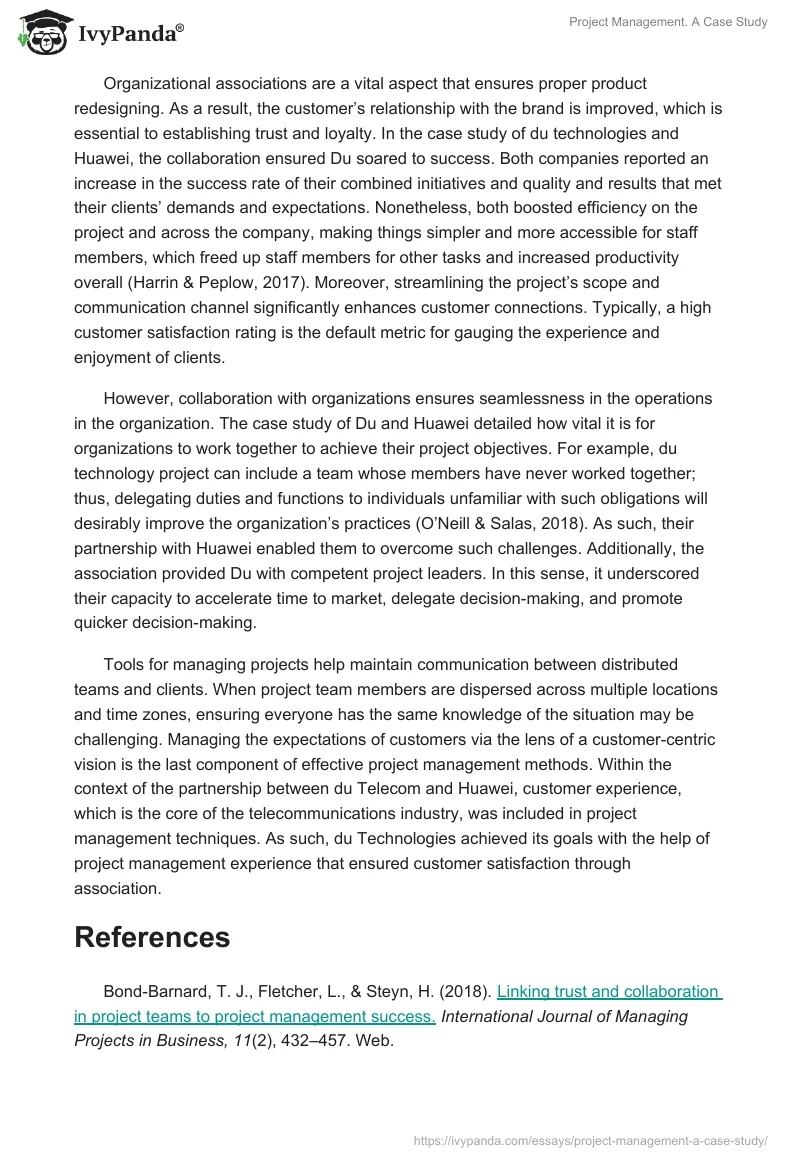The connection with the customer and their experience is an essential business driver in ensuring the organization’s project purposes are achieved. They are the most critical stakeholders in project managers’ projects. On the other hand, the team’s management inside the organization is another significant factor in project success. In most cases, those who run businesses discover that they are being tugged in several ways. As a consequence of this, maintaining harmony between the delivery teams and the clients is a challenging endeavor.
In this sense, the case study of du Telecom and Huawei Technologies Co. Ltd union underscores the need for merging to enhance project achievement. Du Telecom’s bid to capture the market compelled them to associate with Huawei to ensure they achieved the market edge. As such, project management is fundamental for customer experience. In this regard, du Telecom entered the market with much competition. Nevertheless, they managed to capture nearly 40% of the region’s mobile market share and expanded at an annual pace of more than 32% (Project Management Institute, 2015). Despite the fact that Du Technologies was competing in a sector that was already highly competitive, they managed to pose a considerable threat to the already established firms by producing quality products, thanks to their union with Huawei Technologies. Collaboration is a fundamental aspect that most upcoming business projects should consider, and failing to do this, the companies are susceptible to deterioration.
In order for corporation relationships between organizations to be effective, there must be a set of tools in place to improve communication and productivity. These tools are the engines that fuel their productivity, which ultimately aims to achieve maximum visibility and boundless cooperation. For example, enhancing the whole customer experience may be accomplished by using design technology, which can link and automate operations. It ensures that all public-facing assets’ overarching direction, narrative, and branding are in perfect harmony with one another (Bond-Barnard et al., 2018). It may be possible to successfully communicate expectations and share a unified vision when special teams work on the text and the images.
Organizational associations are a vital aspect that ensures proper product redesigning. As a result, the customer’s relationship with the brand is improved, which is essential to establishing trust and loyalty. In the case study of du technologies and Huawei, the collaboration ensured Du soared to success. Both companies reported an increase in the success rate of their combined initiatives and quality and results that met their clients’ demands and expectations. Nonetheless, both boosted efficiency on the project and across the company, making things simpler and more accessible for staff members, which freed up staff members for other tasks and increased productivity overall (Harrin & Peplow, 2017). Moreover, streamlining the project’s scope and communication channel significantly enhances customer connections. Typically, a high customer satisfaction rating is the default metric for gauging the experience and enjoyment of clients.
However, collaboration with organizations ensures seamlessness in the operations in the organization. The case study of Du and Huawei detailed how vital it is for organizations to work together to achieve their project objectives. For example, du technology project can include a team whose members have never worked together; thus, delegating duties and functions to individuals unfamiliar with such obligations will desirably improve the organization’s practices (O’Neill & Salas, 2018). As such, their partnership with Huawei enabled them to overcome such challenges. Additionally, the association provided Du with competent project leaders. In this sense, it underscored their capacity to accelerate time to market, delegate decision-making, and promote quicker decision-making.
Tools for managing projects help maintain communication between distributed teams and clients. When project team members are dispersed across multiple locations and time zones, ensuring everyone has the same knowledge of the situation may be challenging. Managing the expectations of customers via the lens of a customer-centric vision is the last component of effective project management methods. Within the context of the partnership between du Telecom and Huawei, customer experience, which is the core of the telecommunications industry, was included in project management techniques. As such, du Technologies achieved its goals with the help of project management experience that ensured customer satisfaction through association.
References
Bond-Barnard, T. J., Fletcher, L., & Steyn, H. (2018). Linking trust and collaboration in project teams to project management success.International Journal of Managing Projects in Business, 11(2), 432–457. Web.
Harrin, E., & Peplow, P. (2017). Customer-centric project management. Routledge.
O’Neill, T. A., & Salas, E. (2018). Creating high-performance teamwork in organizations. Human Resource Management Review, 28(4), 325–331.
Project Management Institute. (2015). Enabling a customer-centric experience. Web.


